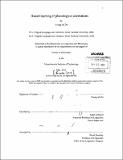Biased learning of phonological alternations
Author(s)
Do, Young Ah
DownloadFull printable version (16.65Mb)
Other Contributors
Massachusetts Institute of Technology. Department of Linguistics and Philosophy.
Advisor
Adam Albright.
Terms of use
Metadata
Show full item recordAbstract
What is the initial state of the grammar when children begin to figure out patterns of phonological alternations? This thesis documents the developmental stages of children acquiring Korean verb and noun paradigms, and provides a unified account using the initial Output-Output correspondence (OO-CORR) bias. It is claimed that OO-CORR constraints are undominated in the initial state but the empirical evidence for this claim is primarily anecdotal. I provide experimental support for the claim. In the acquisition literature, children's innovative forms are normally attributed to imperfect or incomplete mastery of the adult grammar. The evidence presented in this thesis suggests that children in some intermediate stages are able to produce adult forms when the syntactic context demands it, but otherwise they avoid doing so if the forms involve phonological alternations. The specific way that children satisfy OO-CORR constraints is to inflect forms so that the output is faithful to one specific slot of the paradigm, the base form. I show that children select the base form by considering both phonological informativeness and the availability of the surface forms, and try to achieve paradigm uniformity on the basis of the base form in their production. Assuming an initial bias to output-output correspondence constraints, I model the attested learning trajectories. The observed intermediate stages are correctly predicted, showing that the learning of certain alternations is facilitated when they share structural changes with other alternations. Artificial grammar learning experiments confirm that featural overlap of alternations facilitates the learning of the patterns. I propose a learning model that incorporates the attested learning biases.
Description
Thesis (Ph. D.)--Massachusetts Institute of Technology, Dept. of Linguistics and Philosophy, 2013. Cataloged from PDF version of thesis. Includes bibliographical references (pages 198-203).
Date issued
2013Department
Massachusetts Institute of Technology. Department of Linguistics and PhilosophyPublisher
Massachusetts Institute of Technology
Keywords
Linguistics and Philosophy.